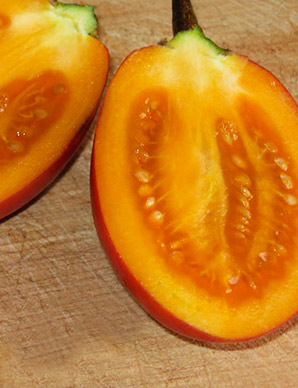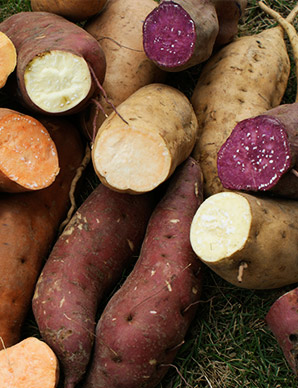Ecuadorian cuisine would be nothing without its uniquely diverse range of fruits, grains, and spices. This guide will help walk you through the food market and over to the dinner table.
Fruits
Maracuyá
This is one of several fruits that come from plants in the Passiflora genus, often referred to in English as “passionfruit.” The maracuyá is distinctly and deliciously tangy, and is popular in juices as well as desserts, such as mousse de maracuyá or cheescake de maracuyá.
Taxo
The taxo is native to Quito, and the bright pink flower of this vine-growing plant is the symbol of the city. Taxo is usually served as a batido, mixed with milk, and it also makes a tasty ice cream flavour.
Naranjilla
The scientific name of this fruit, Solanum Quitoense, signals “Quito” as it’s place of origin. Naranjilla means “little orange,” and when ripe it does indeed resemble a small, leathery, perfectly round orange. Try it in a juice or as an ingredient in desserts or candies.
Tomate de árbol
Native to the highlands of Colombia and Ecuador, this “tree tomato” fruit packs a punch of vitamin C. It’s very tart, so juices made from this fruit tend to use a fair amount of sugar. It’s also a key ingredient in many recipes for ají sauces, offering a tangy complement to spicy chiles.

Beans and Potatoes
Chocho
Known in English as a lupin bean, this legume is full of nutrients, including protein, iron, zinc, and B1. As a snack food it’s typically served with tostada, toasted corn. If you buy pre-packaged chochos in a supermarket they will likely be cooked and salted, but if you find them in an open-air market or vegetable stand take care to wash them first.
Zanahoria Blanca
The locals here in Ecuador call it a “white carrot,” but it’s actually closer to the celeriac family. In other South American countries it’s known as arracha, apio criollo (“Creole celery”), or mandioquinha (Portuguese for “little cassava”). You can cook it about the same way that you would cook a potato– boiled, mashed, fried– but it has an extra-delicate flavour. The chefs at Nuema used it in their version of Ecuadorian llapingachos.
Melloco
This miniature Andean tuber has a distinctive texture: crisp and somewhat viscous, even when cooked. Mellocos come in a variety of colors, ranging from a standard tan skin to bright yellow and pink. The tiny potato most often appears in soups, but is also used cold in dishes akin to a criollo potato salad.
Camote
Best described as a delicious Andean sweet potato. The added benefit of this variety is its bright purple color. One possible preparation is to bake it like you would a normal potato, but “camote chips” are now becoming popular. There are even some commercial brands that sell these roasted slices of camote mixed with plantain and yucca chips.
 Herbs and Spices
Herbs and Spices
Ishpingo
This spice is sometimes called “Amazonian cinnamon”, thanks to its spicy and aromatic flavours. But while cinnamon comes from a kind of bark, ishpingo is actually a flower that becomes hard when dried. This distinctive spice is a key ingredient in traditional recipes for colada morada, a hot beverage typically consumed on the Day of the Dead. Ishpingo is an ancient treasure, used by Amazonian people for its nutritional and medicinal properties.
Hierba Luisa
This is a wonderfully aromatic plant that is found throughout South America. It’s sometimes translated into English as lemongrass, but it’s not like the spicy lemongrass stalks used in Southeast Asian dishes. It’s flavour is more sweet– use it fresh to brew a soothing cup of tea.
Achiote
Achiote grows as a seed pod that looks strangely like the lychee fruit (called achiotillo in Ecuador). The soft seeds are then smashed up into a paste. Some Amazonian communities use the paste as face-paint, but in its culinary use it becomes a bright red, flavorful base for any Ecuadorian refrito.

